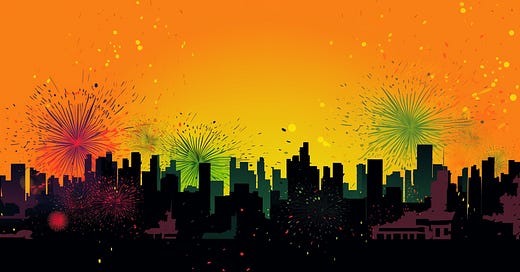Folks, this issue is all about air pollution—a topic that’s close to my heart and one that deserves serious attention. Let’s get into the key insights and facts.
Diwali—the festival of lights—is celebrated worldwide, lighting up homes, streets, and skies in a brilliant display. But while firecrackers dazzle, they also cloud the air with pollution. As air quality takes a nosedive, is it possible to keep the sparkle without the smog?
As Diwali arrives each year, so does India’s pollution season, when cities like New Delhi experience some of the world’s highest levels of air pollution. From October to March, a mix of crop burning, vehicle emissions, and industrial activities creates a steady haze over northern India.
To measure Diwali’s full impact, researchers from Airvoice analysed data from 180 monitoring stations across 14 states, capturing urban hubs and smaller towns alike. The findings reveal sharp PM2.5 spikes on Diwali, with pollution levels varying widely by location.
In some areas, PM2.5 levels soar to an alarming 875 per cent above the safe limit, filling the air with fine particles that easily reach deep into the lungs, affecting health. Air pollution is linked to millions of deaths each year and reduces global life expectancy by an average of 2.2 years. Even in regions with typically lower pollution levels, Diwali brought a dramatic change due to firecracker smoke.
Attempts to curb this pollution through firecracker bans have seen limited success. In New Delhi, where a ban is enforced, PM2.5 levels on Diwali night in 2023 still peaked at 100 per cent higher than on the same date in prior years without firecracker use, raising questions about enforcement.
The silver lining is that air quality tends to return to pre-festival levels within 24 hours, offering temporary relief in most states. However, firecrackers also release toxic metals like aluminium, manganese, and cadmium, which linger long after the visible smoke clears. These metals pose ongoing health risks, contributing to respiratory illnesses and other chronic conditions.
To reduce the impact of pollution on Diwali, eco-friendly firecrackers and alternatives like light and laser shows can help. Raising public awareness about health impacts and promoting lower-emission celebrations, like traditional oil lamps (diyas) displays, can also help lower pollution. However, Diwali is just part of a larger issue—tackling air pollution requires consistent, everyday efforts.
Elia Kabanov is a science writer covering the past, present and future of technology (@metkere)
Illustration: Elia Kabanov feat. MidJourney. Maps: Airvoice.





